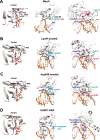Structure-guided sequence specificity engineering of the modification-dependent restriction endonuclease LpnPI
- PMID: 26001968
- PMCID: PMC4499157
- DOI: 10.1093/nar/gkv548
Structure-guided sequence specificity engineering of the modification-dependent restriction endonuclease LpnPI
Abstract
The eukaryotic Set and Ring Associated (SRA) domains and structurally similar DNA recognition domains of prokaryotic cytosine modification-dependent restriction endonucleases recognize methylated, hydroxymethylated or glucosylated cytosine in various sequence contexts. Here, we report the apo-structure of the N-terminal SRA-like domain of the cytosine modification-dependent restriction enzyme LpnPI that recognizes modified cytosine in the 5'-C(mC)DG-3' target sequence (where mC is 5-methylcytosine or 5-hydroxymethylcytosine and D = A/T/G). Structure-guided mutational analysis revealed LpnPI residues involved in base-specific interactions and demonstrated binding site plasticity that allowed limited target sequence degeneracy. Furthermore, modular exchange of the LpnPI specificity loops by structural equivalents of related enzymes AspBHI and SgrTI altered sequence specificity of LpnPI. Taken together, our results pave the way for specificity engineering of the cytosine modification-dependent restriction enzymes.
© The Author(s) 2015. Published by Oxford University Press on behalf of Nucleic Acids Research.
Figures



Similar articles
-
Chemical display of pyrimidine bases flipped out by modification-dependent restriction endonucleases of MspJI and PvuRts1I families.PLoS One. 2014 Dec 8;9(12):e114580. doi: 10.1371/journal.pone.0114580. eCollection 2014. PLoS One. 2014. PMID: 25486533 Free PMC article.
-
Structure of 5-hydroxymethylcytosine-specific restriction enzyme, AbaSI, in complex with DNA.Nucleic Acids Res. 2014 Jul;42(12):7947-59. doi: 10.1093/nar/gku497. Epub 2014 Jun 3. Nucleic Acids Res. 2014. PMID: 24895434 Free PMC article.
-
Structure and mutagenesis of the DNA modification-dependent restriction endonuclease AspBHI.Sci Rep. 2014 Mar 7;4:4246. doi: 10.1038/srep04246. Sci Rep. 2014. PMID: 24604015 Free PMC article.
-
DNA Base Flipping: A General Mechanism for Writing, Reading, and Erasing DNA Modifications.Adv Exp Med Biol. 2016;945:321-341. doi: 10.1007/978-3-319-43624-1_14. Adv Exp Med Biol. 2016. PMID: 27826845 Free PMC article. Review.
-
Proteins That Read DNA Methylation.Adv Exp Med Biol. 2016;945:303-320. doi: 10.1007/978-3-319-43624-1_13. Adv Exp Med Biol. 2016. PMID: 27826844 Review.
Cited by
-
Characterization of BisI Homologs.Front Microbiol. 2021 Jul 1;12:689929. doi: 10.3389/fmicb.2021.689929. eCollection 2021. Front Microbiol. 2021. PMID: 34276622 Free PMC article.
-
A protein architecture guided screen for modification dependent restriction endonucleases.Nucleic Acids Res. 2019 Oct 10;47(18):9761-9776. doi: 10.1093/nar/gkz755. Nucleic Acids Res. 2019. PMID: 31504772 Free PMC article.
-
Crystal structure of the modification-dependent SRA-HNH endonuclease TagI.Nucleic Acids Res. 2018 Nov 2;46(19):10489-10503. doi: 10.1093/nar/gky781. Nucleic Acids Res. 2018. PMID: 30202937 Free PMC article.
-
The N-terminal domain of Staphylothermus marinus McrB shares structural homology with PUA-like RNA binding proteins.J Struct Biol. 2020 Sep 1;211(3):107572. doi: 10.1016/j.jsb.2020.107572. Epub 2020 Jul 8. J Struct Biol. 2020. PMID: 32652237 Free PMC article.
-
Non-Canonical Helical Structure of Nucleic Acids Containing Base-Modified Nucleotides.Int J Mol Sci. 2021 Sep 2;22(17):9552. doi: 10.3390/ijms22179552. Int J Mol Sci. 2021. PMID: 34502459 Free PMC article. Review.
References
-
- Ohki I., Shimotake N., Fujita N., Jee J., Ikegami T., Nakao M., Shirakawa M. Solution structure of the methyl-CpG binding domain of human MBD1 in complex with methylated DNA. Cell. 2001;105:487–497. - PubMed
Publication types
MeSH terms
Substances
Associated data
- Actions
LinkOut - more resources
Full Text Sources
Other Literature Sources
Molecular Biology Databases

